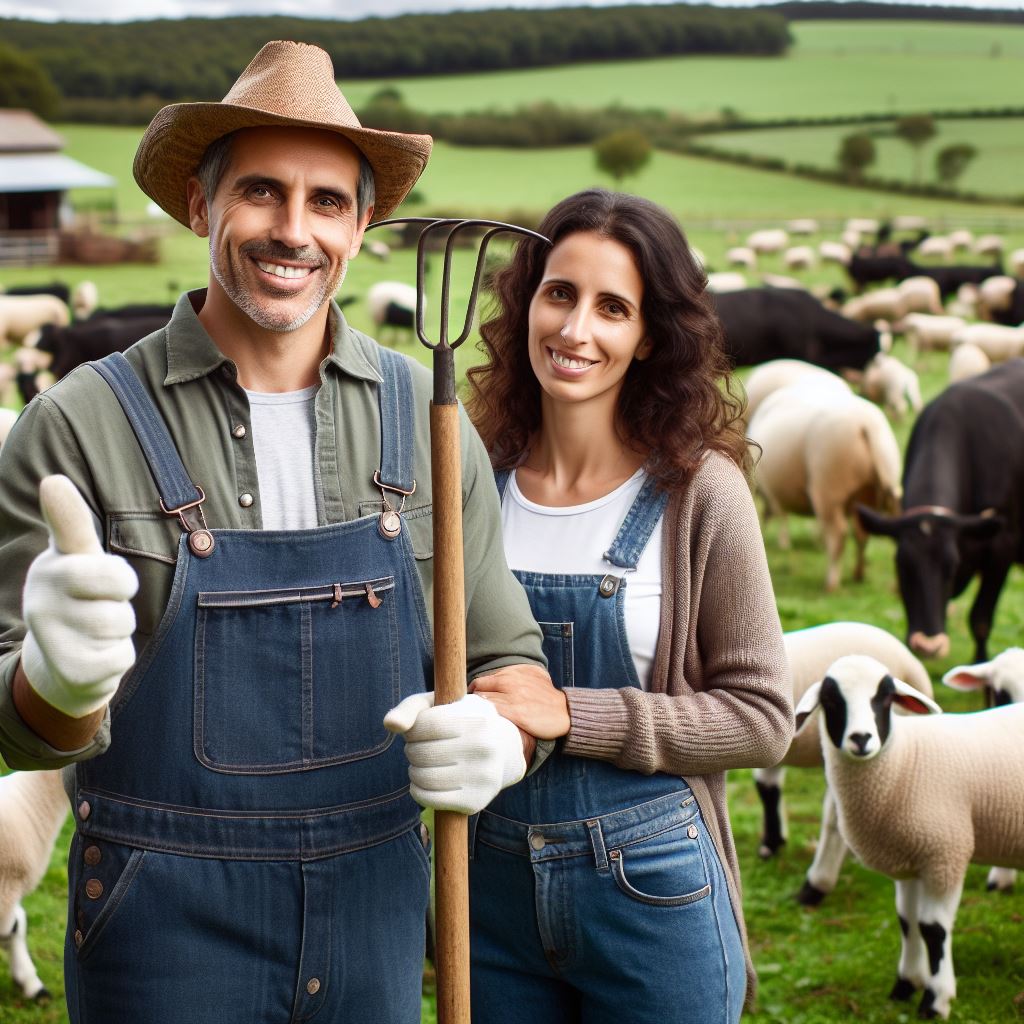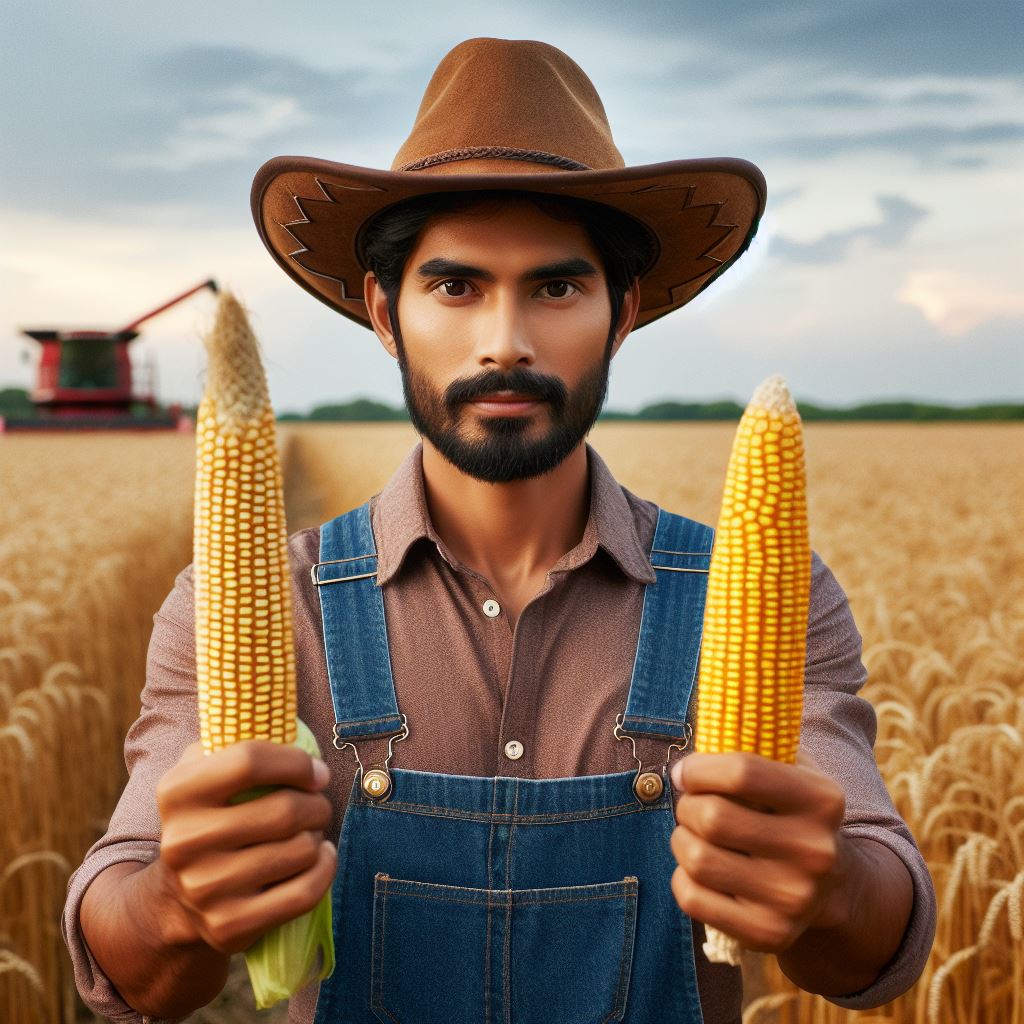Introduction
Brief overview of Canadian livestock farming industry
Livestock farming industry in Canada is a vital sector that contributes significantly to the country’s economy and food production.
With a vast landmass and favorable climate, Canada has a diverse range of livestock, including beef cattle, dairy cows, pigs, and poultry.
This industry not only provides employment opportunities but also supports rural communities.
Purpose of the blog post
The purpose of this blog post is to delve into the world of Canadian livestock farming and provide readers with valuable insights.
Through in-depth analysis and research, we aim to shed light on the challenges, trends, and opportunities within this sector.
Whether you’re a farmer, a consumer, or simply interested in Canadian agriculture, this blog post will provide you with a comprehensive understanding of the industry.
Importance of understanding livestock farming in Canada
Understanding livestock farming in Canada is of utmost importance.
It enables us to appreciate the crucial role it plays in ensuring food security for the nation.
Canadian livestock farming not only supplies domestically but also exports high-quality products worldwide.
Moreover, this industry significantly contributes to the Canadian economy, bolstering GDP and creating jobs.
By comprehending the intricacies of livestock farming in Canada, we can work towards sustainable practices that benefit the environment and animal welfare.
Additionally, understanding the challenges faced by farmers allows us to support them in maintaining a resilient and thriving industry.
Stay tuned for the upcoming sections as we dive into various aspects of Canadian livestock farming, revealing insights and shedding light on this crucial sector.
Overview of Canadian Livestock Farming
In this section, we will provide an overview of Canadian livestock farming, focusing on the main types of livestock farmed in Canada, the contribution of livestock farming to the Canadian economy, and statistics on the number of livestock farms in Canada.
Main types of livestock farmed in Canada
- Beef cattle: Beef cattle farming is one of the largest sectors in Canadian livestock farming.
- Dairy cattle: Canada is known for its high-quality dairy products, and dairy cattle farming plays a crucial role in the industry.
- Swine: Pig farming is also a significant part of Canadian livestock farming, providing a source of pork and other related products.
- Poultry: Chicken and turkey farming are prominent sectors within Canadian livestock farming, meeting the demand for poultry products.
- Sheep and goats: The production of sheep and goats in Canada primarily focuses on meat production, but wool also contributes to the industry.
- Horses: Although not primarily for meat production, horse farming is a popular sector in Canada, with a focus on breeding, racing, and equestrian activities.
Contribution of livestock farming to the Canadian economy
Livestock farming significantly contributes to the Canadian economy in various ways:
- Direct employment: Livestock farming provides direct employment opportunities for thousands of Canadians across the country.
- Exports: Canadian livestock products, such as beef, pork, and dairy, are in high demand globally, contributing to the country’s export revenue.
- Indirect economic activity: Livestock farming stimulates other industries such as feed production, veterinary services, and equipment manufacturing.
- Rural development: Livestock farming is often concentrated in rural areas, contributing to their economic development and sustainability.
- Purchase of goods and services: Livestock farmers regularly invest in equipment, machinery, and other supplies, boosting local businesses.
Statistics on the number of livestock farms in Canada
As of the latest available data:
- Canada has approximately 193,492 agricultural operations, with 138,485 of them involved in livestock farming.
- The number of livestock farms has been relatively stable in recent years, with a slight decline due to consolidation and changing market dynamics.
- Beef cattle farms represent the largest portion of livestock farms in Canada, accounting for around 34% of the total.
- Poultry farms have seen significant growth, indicating the increasing demand for poultry products in the country.
- The average size of a livestock farm in Canada is approximately 1,271 acres, varying based on the sector and region.
Therefore, Canadian livestock farming encompasses various types of livestock, each making a valuable contribution to the Canadian economy.
From beef and dairy cattle to swine, poultry, and sheep and goats, these sectors drive employment, exports, and economic activity.
With a significant number of livestock farms spread across the country, the industry plays a vital role in supporting rural communities and sustaining Canada’s position in the global livestock market.
Read: Conservation Science Degrees: A Guide
Regulations and Standards in Canadian Livestock Farming
Overview of government regulations and policies
- The Canadian government has implemented various regulations and policies to ensure the welfare of livestock.
- These regulations cover areas such as animal health, food safety, and environmental sustainability.
- The objective is to maintain high standards in livestock farming and protect the interests of consumers.
- The regulations are enforced through inspections, audits, and penalties for non-compliance.
Animal welfare standards in Canadian livestock farming
- Canada has strict animal welfare standards that govern the treatment and care of livestock.
- These standards include provisions for housing, nutrition, handling, and transportation of animals.
- Livestock farmers are required to provide adequate space, clean and comfortable conditions for their animals.
- Canadian livestock farmers are prohibited from using cruel practices like tail docking or dehorning without anesthetic.
- The standards aim to ensure that animals are treated humanely throughout their lives.
Implementation of sustainable practices in livestock farming
- Canadian livestock farming is increasingly focused on implementing sustainable practices to protect the environment.
- Farmers are adopting practices such as rotational grazing, which promotes soil health and reduces greenhouse gas emissions.
- Efforts are being made to minimize water use and manage waste responsibly to minimize environmental impact.
- Livestock farmers are encouraged to use alternative energy sources and reduce their reliance on fossil fuels.
- Sustainable practices not only benefit the environment but also contribute to the long-term viability of the industry.
Government regulations and policies are pivotal in safeguarding livestock well-being and upholding high standards in Canadian farming.
They encompass animal welfare, food safety, and environmental sustainability, safeguarding consumer interests and the reputation of Canadian livestock products.
Canadian livestock farming prioritizes animal welfare, abiding by stringent standards governing treatment and care.
Farmers provide suitable housing, nutrition, and humane handling, strictly prohibiting cruel practices like tail docking or dehorning without anesthetic.
Sustainable practices have gained momentum, with farmers adopting measures to minimize environmental impact.
Unlock Your Career Potential
Visualize a clear path to success with our tailored Career Consulting service. Personalized insights in just 1-3 days.
Get StartedPractices like rotational grazing enhance soil health and reduce greenhouse gas emissions.
Efforts focus on responsible water use, waste management, and transitioning to alternative energy sources, reducing reliance on fossil fuels.
Most importantly, Canadian livestock farming thrives within a framework of strict government regulations and standards, ensuring animal welfare and environmental sustainability.
Adherence to these regulations, coupled with the adoption of sustainable practices, fosters the industry’s long-term viability, prioritizing both animal welfare and environmental stewardship.
This steadfast commitment positions Canadian livestock farming as a thriving and responsible sector.
Read: Top Canadian Conservation Projects
Benefits of Canadian Livestock Farming
Economic benefits for farmers and communities
- Canadian livestock farming plays a vital role in contributing to economic growth in rural communities.
- The sale of livestock products such as meat, milk, and eggs provides a steady income for farmers.
- Livestock farming creates business opportunities for ancillary industries like feed suppliers and veterinary services.
- It generates revenue through exports of high-quality livestock products to international markets.
- The industry stimulates local economies by supporting jobs and businesses in processing, transportation, and marketing.
Job creation and employment opportunities
- Canadian livestock farming promotes job creation and provides employment opportunities across different sectors.
- Farmers require a diverse workforce for tasks such as animal care, feeding, and facility management.
- Processing plants and slaughterhouses employ workers for meat processing and packaging.
- Transportation companies hire drivers to transport livestock and deliver products to various markets.
- Additionally, the livestock farming sector creates jobs in research, technology development, and veterinary services.
Contribution to the food industry and food security
- Livestock farming plays a crucial role in contributing to Canada’s food industry and overall food security.
- It ensures a consistent supply of high-quality meat, milk, and eggs to meet the growing demand.
- Livestock farming supports a diversified diet by providing protein-rich animal products.
- Canadian livestock products are produced under strict regulations, ensuring consumer safety and quality standards.
- Domestic production reduces dependence on imports and enhances the country’s self-sufficiency in food production.
Canadian livestock farming provides numerous benefits to farmers, communities, and the food industry.
Economic advantages include income generation, business opportunities, and export revenue.
Job creation and employment opportunities span across various sectors, while contributing to food security and ensuring a steady supply of high-quality livestock products for Canadian consumers.
The holistic impact of livestock farming underscores its significance in Canada’s agricultural landscape.
Read: Conservation Scientist Salary in Canada

Challenges in Canadian Livestock Farming
Environmental concerns and sustainability issues
- Limited land availability and increasing urbanization pose challenges for livestock farmers in Canada.
- Livestock farming contributes to greenhouse gas emissions and water pollution, leading to environmental concerns.
- Sustainable farming practices like rotational grazing and manure management are vital for reducing environmental impacts.
- The use of pesticides and chemical fertilizers in livestock farming can harm the ecosystem and human health.
- Farmers face the challenge of balancing economic viability with environmental stewardship in their operations.
- Climate change impacts, such as extreme weather events, also affect livestock production and farm management.
- Encouraging the adoption of sustainable practices through awareness campaigns and government incentives is crucial.
Disease management and biosecurity measures
- Outbreaks of diseases like avian influenza and foot-and-mouth disease can significantly impact livestock farming.
- Effective disease management strategies, including vaccination programs and proper biosecurity measures, are essential.
- Farmers need to monitor livestock health, implement quarantine measures, and maintain strict hygiene protocols.
- Biosecurity planning involves limiting farm access, controlling animal movements, and maintaining clean facilities.
- Regular testing and surveillance for diseases help identify potential risks and prevent their spread.
- Collaborative efforts between farmers, government agencies, and veterinary professionals are crucial for disease control.
- Continual research and education are necessary to stay updated on emerging diseases and effective management practices.
Market fluctuations and trade barriers
- Canadian livestock farmers face challenges due to unpredictable market fluctuations and price volatility.
- Global economic factors, currency exchange rates, and trade policies impact the profitability of livestock farming.
- Trade barriers, such as tariffs and import restrictions, can limit export opportunities for Canadian livestock products.
- Dependence on export markets makes the industry vulnerable to geopolitical tensions and international trade disputes.
- Diversifying markets and developing strong domestic demand can help mitigate the impact of trade barriers.
- Government support through trade negotiations, market development initiatives, and financial assistance is crucial.
- Collaborating with industry associations and investing in innovative marketing strategies can enhance competitiveness.
In essence, Canadian livestock farming faces several challenges, including environmental concerns and sustainability issues, disease management, and market fluctuations.
Addressing these challenges requires a comprehensive approach involving sustainable farming practices, effective disease management strategies, and proactive measures to overcome trade barriers.
Continued research, collaboration, and government support are essential in ensuring the long-term viability and success of the Canadian livestock farming industry.
Read: Emerging Trends in Conservation Science
Technological Advancements in Canadian Livestock Farming
Introduction of Precision Agriculture in Livestock Farming
- Precision agriculture has revolutionized the way Canadian livestock farmers manage their operations.
- Through the use of advanced technology, farmers can now monitor and control various aspects of their livestock production.
- The implementation of sensors and GPS systems allows for precise data collection and analysis, leading to more efficient farming practices.
- Farmers can now optimize the use of resources such as water, fertilizers, and feed, resulting in reduced waste and improved sustainability.
- Furthermore, precision agriculture enables farmers to have real-time information about their livestock’s health, enabling them to identify and address any potential issues promptly.
Use of Automation and Robotics in Farming Operations
- The integration of automation and robotics has significantly transformed Canadian livestock farming.
- Automated systems have streamlined tasks such as feeding, milking, and waste management, reducing the need for manual labor.
- Robotic milkers, for instance, can milk cows more efficiently and precisely, ensuring the highest quality milk production.
- In addition, automated feeding systems can provide accurate portions of feed tailored to each animal’s specific nutritional needs.
- These advancements not only increase productivity but also improve animal welfare by reducing stress and providing consistent care.
Future Prospects of Technology in Canadian Livestock Farming
- The future of technology in Canadian livestock farming looks promising with ongoing advancements.
- Artificial intelligence and machine learning can further enhance decision-making processes in livestock management.
- Smart farming systems can analyze vast amounts of data to optimize operations, predict disease outbreaks, and improve overall efficiency.
- Genomic advancements allow for better breeding selection, resulting in healthier and more productive livestock.
- Moreover, the integration of blockchain technology can provide transparency throughout the supply chain, ensuring food safety and traceability.
In fact, technological advancements have revolutionized Canadian livestock farming, offering numerous benefits and opportunities.
Precision agriculture has enabled farmers to optimize resources, monitor livestock health, and increase sustainability.
Automation and robotics have streamlined farming operations while improving productivity and animal welfare.
The future prospects of technology in Canadian livestock farming, including artificial intelligence, machine learning, genomic advancements, and blockchain technology, hold immense potential for further improvements in the industry.
Delve into the Subject: Conservation Science: Skills You Need
Success Stories in Canadian Livestock Farming
Case studies of successful livestock farming operations in Canada
Maple Grove Farm: A model of sustainable and profitable livestock farming
Maple Grove Farm, located in Alberta, has emerged as a shining example of success in the Canadian livestock farming industry.
With their commitment to sustainable practices and innovative strategies, Maple Grove Farm has achieved significant growth and profitability.
The Farm’s focus on animal welfare and providing high-quality products has earned them a loyal customer base.
By diversifying their product range and exploring new markets, Maple Grove Farm has ensured a steady stream of revenue.
Rocky Mountain Ranch: Revolutionizing the beef industry with technological advancements
Rocky Mountain Ranch in Saskatchewan has become a leader in the Canadian beef industry through its adoption of cutting-edge technologies.
The Ranch incorporates data-driven decision-making and precision farming techniques to optimize production.
By using GPS tracking and automated feeding systems, Rocky Mountain Ranch has maximized productivity and reduced costs.
This innovative approach has not only increased profits but also improved animal welfare and environmental sustainability.
Northern Breeze Dairy: A prime example of successful dairy farming through value-added products
Northern Breeze Dairy, situated in Ontario, has achieved remarkable success by focusing on value-added dairy products.
They have diversified beyond traditional milk production to include artisanal cheeses, yogurt, and other dairy products.
Northern Breeze Dairy’s commitment to quality and innovation has earned them accolades and a loyal customer base.
By exploring niche markets and promoting their products through local partnerships, they have experienced significant growth.
Innovative practices and strategies leading to success
Embracing technology and automation
Successful Canadian livestock farmers have embraced technology and automation to streamline operations and increase efficiency.
Automated feeding systems, GPS tracking, and data analysis help farmers optimize resource allocation and improve productivity.
Implementing sustainable farming practices
Livestock farmers who prioritize sustainability by reducing waste, using renewable resources, and practicing responsible land management are more likely to succeed.
Sustainable farming practices not only benefit the environment but also attract an eco-conscious consumer base.
Diversifying product range and exploring new markets
Successful farmers understand the importance of diversifying their product range and exploring new markets to minimize risks and maximize profits.
By offering value-added products or targeting niche markets, farmers can differentiate themselves and capitalize on untapped opportunities.
Lessons learned from successful farmers
Adaptability is key
Successful farmers understand that the agriculture industry is constantly evolving, and they must be adaptable to thrive.
They are willing to embrace new technologies, learn from failures, and adjust their strategies as needed.
Collaboration and networking are invaluable
Successful farmers actively seek networking opportunities to learn from their peers, share knowledge, and discover new industry trends.
Collaboration with other stakeholders, such as researchers, universities, and government agencies, also helps foster innovation and growth.
Continuous learning and improvement
Successful farmers invest in continuous learning and seek out educational resources to stay updated on the latest practices and technologies.
They are open to new ideas, attend conferences, and participate in workshops to gain insights and improve their farming operations.
In short, Canadian livestock farming success stories highlight the importance of sustainability, innovation, diversification, and adaptability.
By learning from these case studies and implementing the strategies and practices discussed, aspiring farmers can increase their chances of achieving success in the Canadian livestock farming industry.
Conclusion
Recap of key insights on Canadian livestock farming
In this section, we explored the various aspects of Canadian livestock farming.
We learned about the importance of this industry for the country’s economy and food security.
We discussed the different types of livestock raised in Canada, including cattle, pigs, and poultry.
Additionally, we delved into the challenges faced by farmers, such as disease outbreaks and climate change.
Importance of supporting and promoting sustainable livestock farming
It is crucial for consumers to understand the significance of supporting sustainable animal husbandry practices.
By choosing products from farms that prioritize animal welfare, environmental conservation, and ethical treatment, we can contribute to a healthier and more sustainable future.
Sustainable farming methods, such as rotational grazing, responsible waste management, and reduced antibiotic use, help to minimize the negative impact of animal husbandry on the environment and animal welfare.
Call-to-action for readers to be informed consumers and support local farmers
As consumers, we have the power to make a difference by being informed about our choices.
By buying locally-produced meat and dairy products, we not only support local farmers but also reduce our carbon footprint.
We should also advocate for transparent labeling and traceability, ensuring that we know where our food comes from and how it was produced.
Let’s take a stand for sustainable and ethical Canadian animal husbandry, supporting the farmers who work tirelessly to provide us with quality products while preserving our environment and animal well-being.




